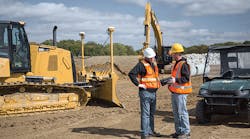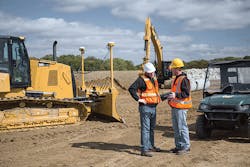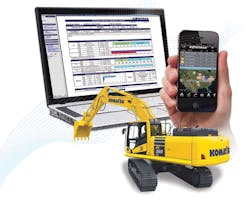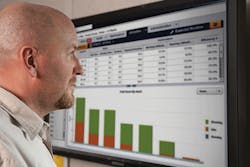This file type includes high-resolution graphics and schematics when applicable.
How wide of a net will be cast with the Internet of Things? Gartner Inc.’s latest research suggests 4.9 billion connected endpoints or “things” will be in play in 2015. By 2020, Gartner predicts that number could reach 25 billion.
Heavy-equipment manufacturers are responding to the IoT market potential by offering solutions that allow their customers to use big data to capture analytics of the equipment on the jobsite. Adopting and incorporating technology that collects key data can help construction companies improve business processes by increasing efficiencies, reducing downtime, and ultimately improving the bottom line, which is the one of the primary objectives on any construction project.
As companies look for ways to improve efficiencies and equipment utilization, they must also find a method to monitor and measure the data that will ultimately drive decisions. As more sensors integrate into operating equipment, it piles up the amount of available data. This requires the sampling rates to increase as well in order to monitor, record, and control effectively.
“Industry partnerships are developing to combine core competencies in the collection, translation, and manipulation of this data,” says Matt Beinlich, Deputy Director, Business Solutions Group, Komatsu America Corp. “Individual points of data, or a sampling of only one criterion, doesn’t necessarily represent anything of value. Often times, coupling data is required. Identifying the key measurements, or metrics, is where these partnerships will add value”
Data collection of machine performance, maintenance, and scheduling is not a new practice, but that data was only useful for looking at what happened in the past. IoT allows companies to monitor in real time and make changes on the fly. Properly utilized data can help lower operating costs by reducing fuel expenses and eliminating unproductive machine hours that increase repair and maintenance costs.
The move to cellular communication systems from satellite has allowed for cheaper and greater bandwidth availability. Early satellite systems were somewhat effective, but costly and cumbersome to deploy and not always reliable. Smartphones, tablets, and their associated apps are making the data transfer quicker, easier, and much more cost-effective.
“The limiting factor for telematics has always been the communication systems,” says Beinlich. “For example, in earlier generations, we would transmit a machine’s maximum, minimum, and average engine oil temperature for a 20-hour period (three data points). Our next generation will capture and communicate the engine oil parameter every second. The sensor sample rate hasn’t changed much, but our ability to get the data off the machine wirelessly has improved dramatically.”
IoT is shifting the traditional business model, too. Equipment manufacturers have moved toward a service-based model, thus providing customers with aftermarket solutions that can help determine what to do about the data presented by new equipment.
Designing proprietary hardware and software for remote monitoring systems is virtually included as standard equipment on many companies’ construction and mining machines. Some key properties are communications and data services.
“For example Komtrax, one of Komatsu’s proprietary hardware/software systems for remote sensing, has approximately 60k machines in the USA and Canada, and a total of 400k worldwide,” says Beinlich. “And equipment with remote sensing will continue to increase.”
Komtrax features a variety of reports and records that customers can use to monitor, as well as make informed decisions on, their equipment and operations:
• Fleet reports
• Machine-history reports
• Status summaries
• Location summaries
• Energy savings
• Fuel consumption
• Attachment usage
• Travel records
• Working-load records
• Caution records
As with any industry, the goal is to increase efficiency and reduce waste. When it comes to heavy equipment, manufacturers are deploying solutions to resolve some rather unique challenges. One trend is to offer multiple ways of accessing data, such as an app or website. Customers may also review as much or little data as they wish. The service-style business plan offers products for free; then, companies can charge for services like customized reports sent directly to customers on a monthly basis.
Fleet Scheduling and Management
The key contribution for the IoT is the potential for significant increases in productivity of equipment in the field. “Customers are constantly asking ‘How do I get the most efficiency and productivity as I can?,’” says Craig Brabec, Chief of Analytics at Caterpillar. “Some advantages of installing and monitoring machine sensors are the ability to view operational activity and the associated wear patterns. This visibility represents how the equipment is being used and its performance.”
Remote monitoring systems also allow users to stay informed about machine location, changes such as fuel status and machine performance, or maintenance needs. The ability to seamlessly gather important data, such as working effort and idle time, helps coax operators to improve efficiencies and accomplish more work faster while burning less fuel, saving millions of gallons of fuel. This data provides the knowledge to make fact-based, strategic business decisions regarding machines and their operations. When utilized correctly, it can lead to increased productivity and availability, proactive decisions, and smarter management.
“Maintenance schedules can be tracked and provide essential information, such as when does the oil need to be changed, or how many more hours remain before tracks need to be replaced,” says Brabec. “Equipment’s uptime, downtime, and idle time can all be tracked to aid in these maintenance decisions. Data can also be manipulated and combined with other vital information, such as operator performance and site productivity. It can show how efficient a specific machine is with a particular operator. Machine data in combination with other data is what drives decisions.”
The ability to maintain production while reducing the amount of equipment on-site is another benefit derived from remote sensing. Tracking a fleet of machines on multiple sites can deliver more efficient logistics for equipment.
Overall, critical data and key decision metrics provided by remote monitoring include:
• Service meter reading
• Equipment location
• Fuel consumption
• Dashboard cautions
• Maintenance reminders/notifications
• Abnormality codes
• Out-of-area alerts
• Movement-position reports
• Operation hours
• Travel hours
• Odometer readings
• Dump count
Predictive Analytics
Tracking maintenance schedules is convenient, but another goal is the capability to predict maintenance or failures. While equipment breakdowns are an inevitable part of the process, the ability to monitor equipment in real time can greatly reduce these instances, and makes it possible to stop use of the equipment, dispatch the part to the field, and handle the necessary repairs quickly. This can also prevent additional equipment breakages due to a cascading effect of damages, which ultimately reduces downtime and repair costs, and keeps projects on schedule.
“On-board diagnostics can provide the ability to make real time changes,” says Brabec. “Diagnostics, including the use of sensors, can monitor unique wear patterns based on the environment and different environmental conditions. For example, a landfill will develop different wear patterns than a salt mine. Predictive analysis can maximize uptime and decrease overall costs that will continue to grow the off-road telematics market.”
Autonomously Controlled Vehicles Boost Safety
Operator safety is a primary concern in construction or mining projects. The ability to remotely program, monitor, and control equipment becomes a significant advantage to operator safety. For instance, many mining operations are challenged by getting operators to and from the equipment. Fully autonomous capabilities allow operations to continue without the need for an operator, in addition to enhancing safety as well as efficiency.
“Autonomy is one significant and exciting direction the industry is headed. The safety aspect of controlling and managing equipment in potentially hazardous environments without the presence of an operator is very appealing,” says Brabec. “The ability to access and control vehicles remotely is an amazing achievement from a safety perspective, but that also means access can potentially be obtained for nefarious means as well. Caterpillar has a dedicated security team for autonomy projects. As more data becomes available, protecting key data and information is integral to the service.”
As more heavy-equipment sensors become connected, the need to collect and make meaningful use of the data is a challenge that’s brought together big-data companies and manufacturers. The ability to remotely monitor and control heavy equipment operating within harsh environments provides for inherent operator safety, as well as a better understanding of the overall operation costs and the ability to make critical business decisions that will benefit a company’s bottom line.
Kevin Russelburg is a technology writer, engineer, and manufacturing professional in the Chicago, Ill. area.




